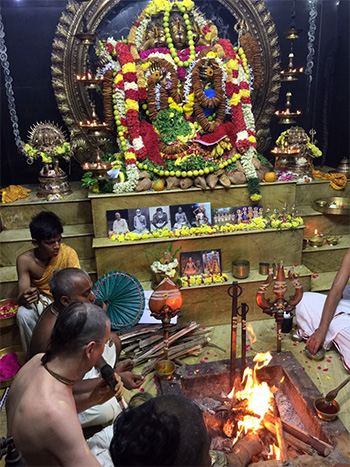Question: While reading Prabhupada’s translation of the Bhagavad Gita, I have read about three different Vishnus (Karanodakashayi Vishnu, Garbhodakashayi Vishnu, and Kshirodakashayi Vishnu). Could you please explain the difference between these three Vishnus?
The word Vishnu actually refers to a category known as Vishnu-tattva, or the category of God. There are many definitions of the name Vishnu, but the basic is “He who has entered everywhere”, in reference to God’s omnipresence as the paramatma. Within the category of Vishnu-tattva are included all of the unlimited incarnations and expansions of God.
There are some expansions that also bear the particular name “Vishnu”, three of which you have mentioned, the Kshirodakashayi Vishnu, Garbhodakashayi Vishnu, and the Karanadakashayi Vishnu (Maha Vishnu).
The Karanodakashayi Vishnu (Maha Vishnu) is the first Purusha avatar who is lying on the causal ocean (karana-udaka). From him the innumerable universes manifest as he exhales. And into Him the universes are destroyed as He inhales.
He expands into each universal shell as the Garbhodakashayi Vishnu. This Vishnu is lying on the universal waters that originate from His persperation, and which fill the universe half way. In his navel is a lake, and from that lake grows a lotus stem. Lord Brahma is born within that lotus. Inside the stem of the lotus are the fourteen planetary systems.
This Vishnu expands as Kshirodakashayi Vishnu who resides in Shveta Dvipa on the milk ocean. This planet is actually a Vaikuntha planet that the Lord manifests within the material universe. In reality it is more like a window through the material covering, which allows one to see a portion of the spiritual realm. It is an eternal abode, and it continues to exist even after the destruction of the universe.
This third purusha avatara is whom we commonly refer to as Vishnu in reference to the trinity – Brahma, Vishnu and Shiva. It is this form of Vishnu who expands as paramatma within everyone’s heart.
The system of the Lord’s incarnations is that all incarnations come through the form of Kshirodakashayi Vishnu in Shveta Dvipa. Lord Brahma along with the devas stand on the shore of the milk ocean and pray to the Lord to incarnate. They are not able to see the Lord, but Lord Brahma receives confirmation from within his heart.
Factually there is no difference between one Vishnu form and another, as they all belong to the same category of Vishnu-tattva – the Supreme Person. Krishna is not a different personality from Rama, and Rama is not a different personality from Narayana. They are one and the same. The only difference is in what they choose to manifest to their devotees.
We can understand this from a simple example. A man is having a wife and children. When the man is addressed by the wife, he acts in a particular way. When the child approaches the father, he acts in yet another way. And when the workers under him approach him, he responds in a completely different way. Thus one personality is taking three forms according to the people whom he is interacting with. The office manager is not a different person from the husband, nor from the father, yet they act completely different. The supreme category of Vishnu-tattva takes different appearances according to the mood of the devotees approaching him. There is no higher and lower capacity among the expansions and forms of God. But some forms of God choose to withhold certain aspects of their oppulences.
Receive our daily email newsletter on Hinduism, Yoga, Meditation, Ayurveda and Natural Healing.







The Karanodakashayi Vishnu (Maha Vishnu) is the first Purusha avatar who is lying on the causal ocean (karana-udaka). From him the innumerable universes manifest as he exhales. And into Him the universes are destroyed as He inhales.
My question: Does His inhalation coincide with the end of Bramha”s life when annihilation is supposed to be happenning?